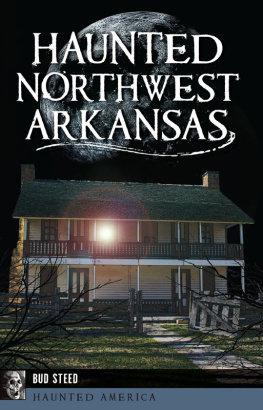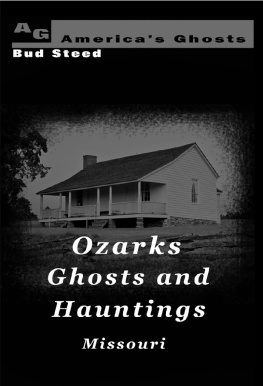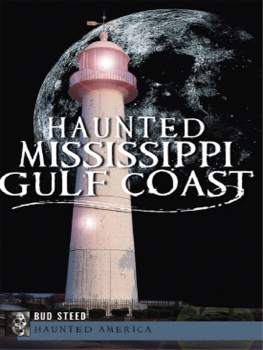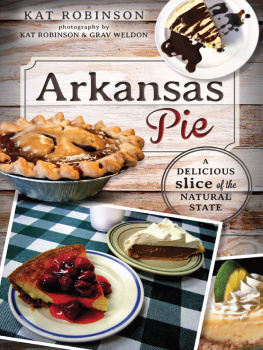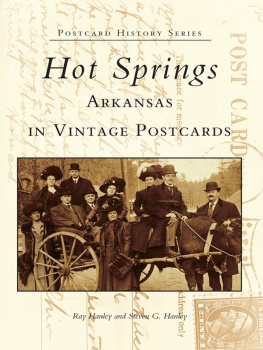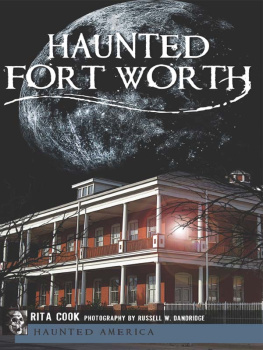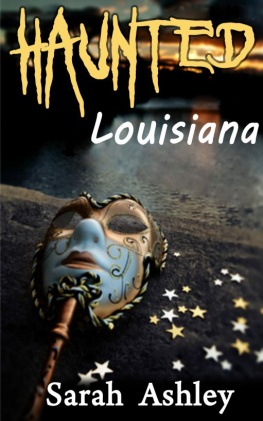


Published by Haunted America
A Division of The History Press
www.historypress.net
Copyright 2017 by Bud Steed
All rights reserved
All images are by the author unless otherwise noted.
First published 2017
e-book edition 2017
ISBN 978.1.43966.295.3
Library of Congress Control Number 2017945020.
print edition ISBN 978.1.62585.956.3
Notice: The information in this book is true and complete to the best of our knowledge. It is offered without guarantee on the part of the author or The History Press. The author and The History Press disclaim all liability in connection with the use of this book.
All rights reserved. No part of this book may be reproduced or transmitted in any form whatsoever without prior written permission from the publisher except in the case of brief quotations embodied in critical articles and reviews.
This book is dedicated to my wife, Jennifer Lynn Steed, who, in all our years together, has never once lost faith in either me or my sometimes crazy plans. She is the rock upon which our family stands and the one true love of my life. This book is also dedicated to my children, Bobbi Jo, David, Sean, Ciara Jo and Kerra Lynn. You all are great kids, and I cherish each of you more than you will ever know.
CONTENTS
ACKNOWLEDGEMENTS
I would like to acknowledge all the help and support that I obtained while writing this book.
First and foremost, I would like to thank my wife, Jennifer, for all the assistance that she gave to me while I was researching this book. From keeping me company during the long drives to waiting patiently while I conducted interviews or took photographs, your support, love and companionship made the research behind this book extremely enjoyable. Also, special thanks to my son Sean Steed for riding shotgun with me throughout Northwest Arkansas while I was taking additional photos for the book, even though I was sick with the flu.
I would also like to extend my thanks to Matt Wallace, Matthew Massey, Bert Casper and everyone at SMC Packaging Group for their support. The willingness of everyone to stand there patiently while I rambled on about one haunting or another that I had just discovered or a paranormal investigation that I was about to embark on is truly amazing, not to mention much appreciated.
Special thanks to Keith Scales, the director of ghost tours for both the Crescent and Basin Park Hotels, for taking the time to speak with me and share some of the history and some interesting stories of the alleged hauntings of both properties; your knowledge and time are greatly appreciated.
Last but not least, thanks to everyone who shared their stories with me about their paranormal experiences in Northwest Arkansas; it was great fun speaking with all of you and hearing your stories.
DISCLAIMER
While I have strived to ensure the accuracy of the stories and the history behind them, I think that it is important to remember that they are, indeed, just ghost stories. Whether they are factual or not is impossible to say, as no one has ever proven the existence of life after death. When possible, I have included in the stories personal experiences obtained during investigations and during research trips, but that is in no way definitive proof that a haunting is going on at that particular site; it simply means that I had an experience that I couldnt debunk or find a logical answer for. Additionally, those stories that I can find very little truth behind, or are questionable at best in regard to any factual basis, are still included; even if they are nothing more than urban legend, they are still entertaining and show the process and evolution of the storytelling and legends associated with the area.
All in all, I hope that you enjoy this book and that the stories of ghosts and hauntings might move you to do a little investigating of your own, to seek the truth behind the stories, a task that brings me great joy and fulfillment, as I am sure it will you as well. Read the stories, check into them a little further if you like and come to your own conclusions as to what is true and what is simply an urban legend, but above all else, just have fun with it and enjoy the stories!
INTRODUCTION
Northwest Arkansas is quite the captivating place. The deep hollows and thickly wooded mountains of the Ozarks, coupled with clear streams and an abundance of wildlife, make this part of the country a joy to explore. Hiking trails, exploring cave systems, hunting, fishing, all types of boating and enough historical sites to keep even the most ardent history buff occupied ensure that there is something fun for almost everyone.
But in addition to the natural and historical beauty of the area, there is also a darker and sometimes more sinister past that cant be ignored. Northwest Arkansas has a bloody and turbulent past that some believe contributes to the supernatural occurrences that have been experienced by a large number of people over the years. From bloody Civil War battles to guerrilla raids, from brutal con men to robbers, from sporadic murder to violence, the area has seen more than its fair share of violence and brutality. It has a lot of stories and history to share, and if one would simply take the time to ferret them out, those stories just might shed some light on the reported paranormal experiences that seem so commonplace. It has always been my opinion that behind every ghost story, every alleged haunting and urban legend there has to be a small bit of truth from which the tale sprang; we simply have to dig a little deeper to find it sometimes.
Lets take a real brief look at the history of the area to get a little background on the stories yet to come.
A VERY SHORT HISTORY OF NORTHWEST ARKANSAS
No one really knows when the first inhabitant of Northwest Arkansas first set foot in the Ozark Mountains, but several accounts put it somewhere between 11700 BCE and 9500 BCE. Early indigenous people are thought to have migrated into the region over a long period of time, first following the game and then establishing base camps with more permanent roots in the area, from which they would launch hunting parties. As time progressed, the Native Americans in the eastern part of the state built more permanent villages and cleared some of the lands for planting, but the mountains and valleys of Northwest Arkansas remained largely uninhabited. Small groups traversed the area, setting up temporary camps for several months at a time while they hunted and fished, but for the most part, the area remained largely unsettled.
Members of the Quapaw, Caddo and Osage tribes moved into the area by the early 1500s, with the Osage being more prominent. During that time, the French and Spanish moved into Arkansas, primarily along the Mississippi River, but Spanish explorers frequented the Ozarks of both Arkansas and Missouri in search of riches. Tales of lost Spanish silver mines and buried treasure are abundant in the Ozarks, and there are many accounts of interaction between the natives and Spanish explorers. (You can find out more about lost and buried treasures in my book Lost Treasures of the Ozarks.)
The region changed hands many times, through treaties and eventually purchase, most notably as part of the Louisiana Purchase, when the United States bought it from Napoleon. That brought a flood of settlers into the area, displacing a lot of the Native Americans who called the area home. The population grew quickly, mainly through the development of plantations, with cotton being the principal crop. The quest for statehood brought about the creation of the state of Arkansas on June 15, 1836, in a bill signed by President Andrew Jackson. By the time of the Civil War, most of the Native Americans had been moved to other areas, mostly into the Indian Territory of what is now Oklahoma. While the eastern and southern parts of the state were developed through slavery, the northwestern part had only a small percentage, about 2 percent, of its black population who were held as slaves. Despite the small number of slaves, the northwestern part of the state chose to back the large slaveholding interests and threw its support to the Confederacy.
Next page
